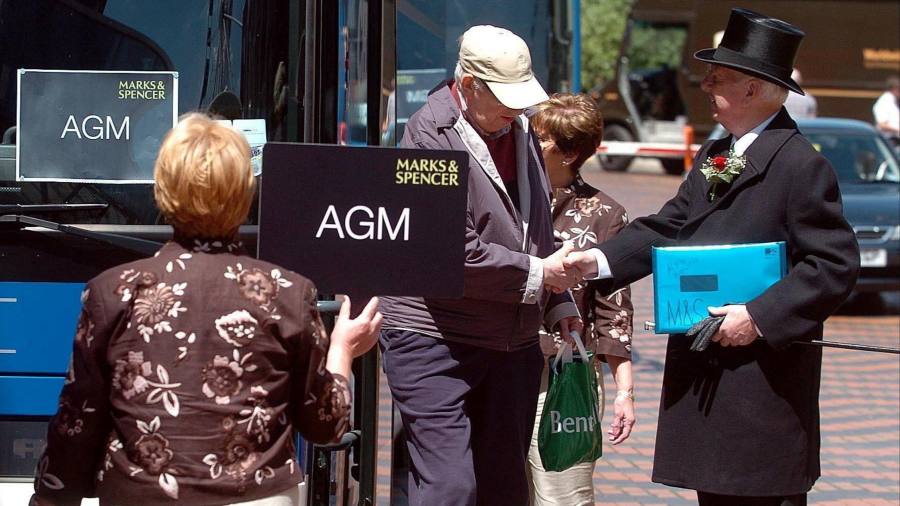
Receive free Advice & Comment updates
We’ll send you a myFT Daily Digest email rounding up the latest Advice & Comment news every morning.
I have attended many annual general meetings across the country over the years and find them an invaluable source of understanding of a business. On one occasion I was even invited to become a non-executive director of a small listed company by the chair at the close of the meeting — the first time I had met him.
I went on to serve for many years — by far the best perk I have ever received for AGM attendance, far superior to the modest product examples, buffets or countless coffees consumed.
I seldom focus on the formal part of the meeting, as most resolutions normally go through with few questions asked. It is the opportunity afterwards to meet with board members informally, in a more relaxed format, and to fraternise with fellow shareholders, that is most valuable. One can learn so much more about the business and personalities running it.
Thus, I was horrified to learn what the FTSE 250 listed retailer Marks and Spencer was planning for its 2023 AGM, which took place on Tuesday this week.
Ahead of the meeting, shareholders — I am not one — were told not to travel to the venue as the meeting would be digitally enabled. There was to be no face-to-face interaction with board members, who would be broadcasting the meeting under studio conditions.
“Any shareholders travelling to the venue against the board’s recommendation will be advised to join the meeting electronically, and will be provided with assistance to do so, if needed,” the company said.
This is an outrageous development and should be opposed by all shareholders before it is embraced as an easy option by other boards. Yes, we live in an increasingly digital world and many shareholders, perhaps the majority, would prefer Zoom-type participation, but the way forward is surely “hybrid” meetings with the option of attendance in person or digital form.
Too often boards forget that we shareholders own the company. The directors are “stewards”, and usually for a limited period. To cut out the opportunity for a relaxed dialogue with directors is totally unacceptable. Frankly, the board of M&S should be ashamed that they have gone along with this approach.
I feel so strongly about the issue that I have put down a question in the House of Lords, asking what assessment the government has made for regulating whether publicly listed companies should hold hybrid AGMs.
M&S’s move is particularly unfortunate at a time when the executive team has brought about a welcome transformation of the business. As a frequent customer I see a much greater range of goods, more attractively displayed, with a much more welcoming feeling. For shareholders, it has just launched a pilot scheme with Interactive Investor that gives nominee shareholders the opportunity to vote at the AGM — digitally, of course.
But if M&S really wants to build bridges with shareholders, it should consider introducing a shareholder’s card with a modest, perhaps 1 per cent open-ended discount on purchases. Another step forward would be to hold regional meetings with shareholders on site after stores have closed for the day.
Asset manager M&G recently held its hybrid AGM, with good results. I have built a meaningful holding in the fund manager, attracted by its 10 per cent yield and the belief that it was undervalued and vulnerable to a bid if it failed to demonstrate growth and direction. Now it is something of a stranded whale, with investors unclear as to its future.
Thus, I went along to the AGM to get a feel of the situation, and hopefully to meet the new team. The well-run hybrid AGM enabled shareholders in person and digitally to question the board, with new chief executive Andrea Rossi taking the opportunity to express his “incredible confidence” in M&G’s future.
Afterwards, over coffee, I had a good hour talking with Rossi and Edward Braham, the new chair and an ex-senior partner at law firm Freshfields. With over 20 years of senior level experience in global insurance and asset management, primarily with Axa, Rossi saw M&G as very much a “sleeping beauty”. He had already publicly eschewed any break-up of the business, arguing it had a strong platform in asset management, wealth management and insurance from which to pursue global growth.
I formed the view that Braham and Rossi, an impressive, confident leader, work well as a team and that, importantly, there was unlikely to be any risk to the attractive dividend. I also talked to Tamim Jabr, executive director of Saudi fund, Kingdom Holdings, which has built a 6 per cent stake in M&G and I noted that Silchester, a very shrewd and successful investor, had accumulated a 5 per cent holding.
Putting these pieces together I came away convinced that M&G had little downside and potentially a big future. Thus I resolved to sell my major Aviva holding, building my stake in M&G further. To my mind, the latter’s global opportunities are greater than Aviva’s, which has sold nearly all its overseas subsidiaries. Time will tell.
Other smaller transactions this past quarter have seen me tidying up and selling some smaller holdings — Lords Trading, Rathbones, Tate & Lyle and Titon, and building up Anpario, Christie, Hollywood Bowl, Secure Trust and Vianet, plus a new addition, Workspace. Challenging times and very depressed valuations create excellent buying opportunities. I also sold a very small slice of “superstar” telecoms services group Cerillion, at £14.50, first bought in 2016 at 83p. If only everything had turned out so well.
Lord Lee of Trafford is an active private investor and a shareholder in all the companies indicated